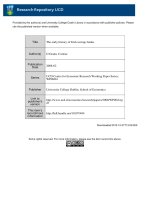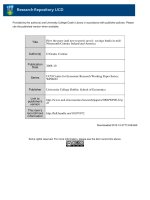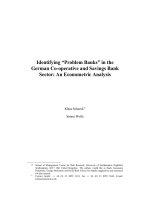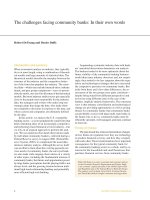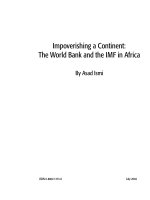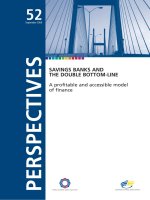Microfinance services by savings banks in Africa - The sleeping giants have started moving, but where are they going? potx
Bạn đang xem bản rút gọn của tài liệu. Xem và tải ngay bản đầy đủ của tài liệu tại đây (442.12 KB, 28 trang )
The global voice of
savings and retail banking
Microfinance services by savings banks in Africa
The sleeping giants have started moving, but where are they going?
2
Table of Content
Main Characteristics of Microfinance in the Region 4
Savings banks in the microfinance landscape in Africa 7
Key features of African Savings Banks 9
1. Accessibility 9
2. Proximity 9
Products and Services 11
1. Lending experiences 12
2. Small Savings Schemes 17
3. Diversifying into insurance and payment services 19
Conclusion and recommendations 23
References 25
Annexe (African WSBI Members’ key figures) 26
For a French version of this report please visit www.wsbi.org or
contact
3
The dominant paradigm in microfinance till nowadays merely recognises microcredit institutions, which
savings banks could not be (and still are not in many cases) in Africa because of their institutional
set-ups that commonly prohibited any form of lending. However, the definition of microfinance has
evolved over the last years from its narrow perspective and the scope of microfinance services largely
take into consideration basic financial services that are needed by vulnerable people.
Recent research works in the field of “Access to Finance” have substantially contributed to change the
mindset as how experts define microfinance. There is a greater awareness that working poor people
even desire more safe and affordable deposit services to protect their little savings. Their demand is also
very high for payment services (including money transfer services) and insurance services.
This larger perspective of microfinance brings African savings banks in the picture. Yet, their contribu-
tion to microfinance is still very often overlooked by experts and policy makers
1
. The purpose of this
study is to survey and give visibility to the activities of savings banks in this field. It complements the
summary report on Microfinance in Africa
2
with hard evidence supported by data on these activities.
The main findings of the present report are as follows:
Savings banks in Africa have managed to provide convenient basic financial services by combining
accessibility (secure, adapted and affordable financial services) and proximity (extensive retail
distribution networks) to their clients. Their potential comparative advantage in deposit-taking
services and money transfer services (including remittances) could be further enhanced through
payment facilities.
Institutional set-ups are changing favourably, but the general trend for savings banks is to reposition
towards low-risk retail banking activities (e.g; current account facilities, collateralised consumer
loans; mortgages, ) and not to become pure microfinance institutions or microfinance banks.
However, there are diverse business models to respond to the pressing market demand for micro-
credit services. Some savings banks have introduced a microcredit scheme in their product line
(Tanzania Postal Bank, National Savings and Credit Bank, Zambia) or opened a specialised window
(National Bank for Development, Egypt) for a direct participation while other have opted for an
indirect participation through linkages (Post Bank Uganda, People’s Own Savings Bank, Zimbabwe)
with sustainable and promising microfinance institutions (e.g., refinancing with wholesale loans for
on-lending to retail microfinance clients).
Where savings banks are direct microcredit providers the individual lending methodology has
generated better results. Loan sizes vary across countries from USD 50 to USD 2,000 (often group
loan) but are in line with the industry average while microloan portfolios range between USD
100,000 and USD 8 million (National Bank for Development, Egypt).
Regulation is an issue for savings banks involved in microfinance because they are submitted to
stringent banking regulations. Microcredit is in principle uncollateralized lending and as such it is
more demanding in capital resources for complying with prudential requirements. In general,
regulation is a limit to the expansion of microcredit programmes run by savings banks.
1 Broadly speaking, African savings banks are providers of microfinance services although they have historically
not been classified among microfinance institutions.
2 Prepared by Mr. Diogal POUYE (WSBI Vice-President in charge of Microfinance)
Executive summary
4
Main characteristics of Microfinance
in the Region
According the Microfinance Information Exchange (MIX) microfinance in Africa, in its myriad of shapes
and forms meets the needs of an increasing number of vulnerable people whether farmers, traders
and micro-entrepreneurs
3
. The industry is growing although disparately due to improved access to
commercial funds, deposits from clients and to a lesser extent equity. However, there are distinctive
features between Subsaharan Africa and the North Africa and across sub regions within Subsaharan
Africa.
Subsaharan African microfinance institutions (MFIs) performs relatively well in global comparison.
Based on an analysis of 163 MFIs undertaken by the Microfinance Information Exchange (MIX)
4
:
The quality of the portfolio is high with an average of 4% of the portfolio at risk for more than 30
days
Much more than in any other region of the world, savings is prominent in the local microfinance
industry and used as a significant source of funds for lending
5
. And while growth has been slow
with regard to credit outreach, deposit mobilisation has expanded significantly over the past years.
In general, microfinance institutions greatly value both credit and deposit services in Subsaharan
Africa.
Figure 1: Breakdown of sources of financing (weighted by assets)
Source: Africa MIX (April 2005)
3
4 Africa MIX - Study on the scope and financial performance of microfinance institutions in Africa (April 2005)
5 Africa MIX - Benchmarking African Microfinance 2006, (November2007), 11 p.
0 %
20%
40 %
60 %
80 %
100 %
Own funds Deposits Loans
Subsaharan
Africa
East Asia
& Pacic
Eastern Europe
& Central Asia
Latin
América
Middle East
& North Africa
South
Asia
5
They are among the most productive MFIs in the world in terms of the number of borrowers and
savers compared to the number of staff (70% of MFIs in Sub-Saharan Africa offer savings services
with three times more voluntary savers than borrowers).
Table 1: Client structure
Subsaharan
Africa
Middle
East and
Northern
Africa
East Asia
and the
Pacific
Eastern
Europe and
Central
Asia
Southern
Asia
Latin
America
and the
Caribbean
Borrowers 2.41 0.37 3.80 0.21 6.57 1.76
Savers 6.32 0.0 30.1 0.04 3.19 0.68
Source: Africa MIX (April 2005)
In line with other regions of the world, microfinance has recognised the determining role of women
and constitutes an efficient instrument for empowering women. More than 61% of the borrowers are
female clients in Subsaharan Africa.
Figure 2: Percentage of women borrowers of MFIs
Source: Africa MIX (2005)
Nonetheless, these good results hide a number of critical challenges that could hold back the develop-
ment of Subsaharan African MFIs. High operating costs and increasing competition are often pointed
out to be the main challenges for the overall microfinance industry. While technology and innovations
could drive the industry to higher levels of efficiency and productivity and help to diversify the product
base; increasing competition will push institutions to lower lending rates, albeit allowing for profit-
making. Credit-only institutions suffer most from from limited access to commercial funding. Evidence
suggests that microfinance institutions, which engage in full intermediation, grow faster and far better
58
60
61
76
80
86
Eastern
Europe
& Central
Asia
Latin
America &
Caribbean
Subsaharan
Africa
Eastern
Asia &
Pacic
Middle
East &
North
Africa
Southern
Asia
6
in outreach and financial terms than those specialising in lending only.
In North Africa, microfinance enjoys one of the most favourable environments for growth, due to low
market penetration rates combined with generally shallow government intervention
6
. The region is
mostly free of competition and high financing costs that bog down the industry in more mature mar-
kets. Microfinance institutions face lower hurdles and can more easily attain profits, all while respond-
ing to the needs of the lower segment of the microfinance market.
However, the microfinance industry in North Africa is slowly starting to show signs of maturity. Access
to concessional funds has so far enabled the sector to boost profits, but competition for these limited
resources is intensifying. Financial costs are rising, albeit slowly, and institutions are outgrowing the
pool of available funds.
Savings services are glaringly absent from the market in light of widespread government reluctance
to the mobilization of deposits by non-bank institutions, though the industry has made tremendous
strides in micro-credit offering. If institutions in the region can maintain productivity, and at the same
time overcome funding and management constraints to building up their institutional capacity, the
market is set to grow further.
The microfinance industry in North Africa is certainly at a critical stage of its development, and current
legislations may need to be revised to open the door to new financing opportunities, including savings
and equity investments.
6
7
Savings banks in the
microfinance landscape in Africa
Savings banks are a legacy of pre-independence times. In most countries, they predated commercial
banks in laying the groundwork for a modern banking system. In those days, they were established
to encourage the monetisation of local economies by mobilising indigenous savings in the form of
deposits. However, the model of postal savings banks was preferred to that of ordinary savings banks
that have the same philosophy. The predominance of this model explains why postal savings banks
count for more than two-third (2/3) of the WSBI membership in Africa (a list of members in Africa is
available in annex).
The rationale of the postal savings bank model has been to use the convenience of post offices to
minimise the cost of mobilising small savings and to maximise outreach. In general, the state guarantee
on their liabilities has been accompanied by statutory obligations to entrust the money with national
Treasuries or invest in government debt. Even today, savings banks are still considered as shadow
instruments for channelling cheap funds into the government budgets.
Despite their significant role in availing financial services to underprivileged groups and communities,
the involvement of savings banks in the microfinance’s arena is often overlooked as many are still
restricted from lending and offering microcredit schemes. However, these restrictions are progressively
lifted, fully or partially, allowing a few to expand the scope of their operations.
The paradigm shift expanding the scope of microfinance services beyond microcredit clearly offers an
important opportunity to reassess the full potential of savings banks in this rapidly changing industry.
From this new perspective, it is not abusive to say that savings banks are genuine microfinance service
providers. As institutions committed in the first instance to the mobilisation of savings and with house-
holds, micro and small enterprises as typical clients, it is undisputable that the “sleeping giants” are
embedded to the microfinance landscape.
Despite this evidence, questioning the desirability of savings banks (particularly postal banks) to intro-
duce lending functions remains on the development finance policy agenda. Pro-arguments support
that with declining interest rates on government debt instruments (Treasury bills and government
bonds) and increasing competition on their traditional captive market segments by microfinance insti-
tutions and commercial banks going into retail lending, savings banks have no choice but to diversify
their range of products and services. Such an evolution would not work without offering credit services
and also reflects the recognition that to achieve their social mission, savings banks need to transform
into client-responsive organisations.
However, some argue that savings banks have not fully exploited their potential under narrow banking
and therefore should be revitalised in this limited financial intermediation scope. In this regard, they
should further enhance their deposit taking and payment functions hence mobilise deposits from the
public to invest freely on financial markets in risk safe debt instruments including private sector issues.
These opinions are supported by “potential down sides of government-owned savings banks entering
credit market (in particular) in political influence over lending decisions” (p. 10)
7
.
7 Graham A.N. Wright, Nyambura Koigi and Alphonse Kihwele: “Teaching Elephants to Tango: Working with Post
Banks to Realise their Full Potential”, published by MicroSave, Nairobi, 2007.
8
Whether allowed or not to lend, what is at stake today is finally a change in the mindset of people who
steer the global microfinance agenda. State-owned banks (e.g; BRAC in Bangladesh, BRI Indonesia,
Nabard India and GSB in Thailand) are the largest microcredit providers in Asia and are recognised and
accepted as such although in some cases they administer subsidised government funds. African savings
banks certainly need support in their endeavour to respond to the huge underserved market and most
particularly to address the pressing demand from their clients.
However, not all WSBI African members have a postal origin and there is private stake in a few institu-
tions. In this group, National Bank for Development (NBD) in Egypt is sole with full private ownership.
The bank has also gained international recognition through its sustainable microcredit program, which
has enabled to disburse more than USD 164 million in nearly twenty years of operations (more infor-
mation is available in Box 1).
Postbank Kenya
9
Key features of African Savings Banks
Accessibility and proximity are embedded in the business model of savings banks in Africa.
Accessibility
A key feature of savings banks’ accounts is the predominance of low balance transactional accounts.
Unlike mainstream banks, which in general apply prohibitive administrative charges, savings banks
have adopted price structures reflecting the fair costs of transactions for small accounts and charging
small fees for regular transactions above a certain number of operations. For example, the deposit
balance was below USD15 for more than three quarters of savings accounts with the WSBI member
in Kenya (2005) and Tanzania (2004) although these accounts represented only 5% and 6% of the
outstanding deposit value respectively.
Table 2: Percentage of savings accounts with a balance below USD 15
Country Institution Number (%) Value (%)
Benin (2001) Postal Corporation 62% -
Burkina Faso
(2001)
Postal Corporation 36% -
Kenya (2007) Post Office Savings Bank 85.1% 5%
Tanzania (2004) Postal Bank 79% 6%
Source: WSBI members
Proximity
Savings banks in Africa are also characterised by nationwide distribution networks to reach out to
the clients in urban, peri-urban and sometimes rural areas. In the cases of postal savings banks, their
networks often match and even overtake that of all other banks together.
Table 3: Number of outlets (not including electronic devices)
Country Institution Number of outlets of
the savings bank
Number of outlets of
other banks
Angola (2005) Banco de Poupança e Crédito 56 -
Benin (2005) Postal Corporation 93 76
Cote d’Ivoire Savings Bank 164 177
Kenya (2007) Post Office Savings Bank 481 443
Morocco (2005) Postal Corporation 1635 1814
Tanzania (2006) Postal Bank 177 232
Tunisia (2005) Postal Corporation 1002 1000
Source: WSBI members and various
10
Among technological options experimented to reach the unbanked and underbanked populations
mostly in the rural areas are the satellite (mobile) branches, which allow to serve financially-excluded
geographical areas where mainstream banks found it unprofitable to set up brick and mortar infra-
structures. Savings banks in Uganda and Zimbabwe operate mobile banking units, which consist of
vans equipped with information and communication technology touring remote communities on fixed
dates to render banking services. Savings banks are also moving beyond traditional networks to offer
branchless banking services and thereby accommodate the market. Electronic devices (ATM, POS,
Cellphone, etc.) are increasingly introduced to handle high volume of low-value transactions.
Postbank Uganda
11
Products and Services
There is a large demand for a variety of financial services among low-income people. Traditionally,
savings banks have focused on savings mobilisation as core business and only introduced other retail
banking services, including insurance and credit schemes at a later stage. In some cases, non postal
savings banks have continued to offer low-value deposit services to the mass market while evolving
into socially-committed retail banks.
Table 4: Breakdown of outlets
Country Institution Branches in
the region
capital
Branches in
other major
cities
Branches in
rural towns
and villages
Satellite/
Mobile
branches
ATMs
Comores Postal
Corporation
2 2 7
Kenya Post Office
Savings Bank
36 49 19
396 (post offices)
Morocco Postal
Corporation
1696 (post offices) 372
Tanzania Postal Bank 47 89 20
Tunisia Postal
Corporation
509 464 45 100
Zambia National Savings
and Credit Bank
13 4 7
Zimbabwe People’s Own
Savings Bank
10 14 6 5 40
160 (post offices)
Source: WSBI members and various
12
Table 5: Products and services offered by selected WSBI members in Africa
Deposit Lending Insurance Payments (including
money transfer
services, card
services)
Country Institution
Benin Postal Corporation x x
Cote d'Ivoire Savings Bank x x x
Ghana Housing Finance Company
Bank
x x
Kenya Post Office Savings Bank x x
Morocco Postal Corporation x x x
Senegal Postefinances x x
South Africa Postbank x x x
Tanzania Postal Bank x x x x
Tunisia Postal Corporation x x
Zambia National Savings and Credit
Bank
x x x
Zimbabwe People’s Own Savings Bank x x x
Source: WSBI members and various
Lending experiences
Regulatory authorities have always been reluctant to grant the permission for entering lending business
to savings banks. However, a certain number of (postal) savings banks (e.g., “Caisse Nationale d’Epargne
et de Prévoyance” (Algeria), (Botswana) Savings Bank, Caixa Economica (Cape Verde), Housing Finance
Company Bank (Ghana), “Banque de l’Habitat” (Mali), Savings and Social Development Bank (Sudan),
Post Bank (Uganda), (Tanzania) Postal bank, National Savings and Credit Bank (Zambia), and People’s
Owned Savings Bank (Zimbabwe)) have managed to secure this permission from their authorities. And,
whenever savings banks engage into lending, their market focus is hardly to extend microcredits but
to develop retail lending services.
1. Retail lending: savings banks’ experiences across Africa
Retail lending experiences of African savings banks vary across countries with some institutions concen-
trating on housing finance in accordance with their by laws while other are tapping the underserved
market of consumer lending with risk less credit schemes.
13
Table 6: Selected features of WSBI Members
Market focus
Country Institution Regulatory
status
Products Segments
Algeria Caisse Nationale d’Epargne
et de Prévoyance
Banks Housing Finance Individuals
Companies
Ghana Housing Finance Company
Bank
Mali Banque de l’Habitat
Botswana Savings Bank Credit/Financial
Institutions
- Consumer
(salary-based)
loans
- Business
(Corporate) loans
Individuals
SMEs
Tanzania Postal Bank
Uganda Post Bank
Zambia National Savings and Credit
Bank
Zimbabwe People Owned Savings Bank
Source: various
Savings banks involved in housing finance are in general specialised institutions that have taken advan-
tage of universal banking licenses to complement their offer with commercial banking products and
services.
Table 7: Value of the loan portfolio
Specialised Housing Finance
Banks
Value
(USD
million)
Credit/Financial Institutions Value
(USD
million)
Caisse Nationale d’Epargne et
de Prévoyance (Algeria)
2,503.13 Savings Bank (Botswana, 2005) 28.1
Housing Finance Company, Bank
(Ghana)
74.3 Postal Bank (Tanzania, March
2007)
20.7
Banque de l’Habitat (Mali, 2005) 137.4 Post Bank (Uganda, 2005) 7.55
National Savings and Credit Bank
(Zambia, 2004)
3.27
Source: WSBI members
The loan portfolios for the group of specialised banks are by far larger compared to that of the second
group formed by institutions with credit/financial institution licenses that are not allowed to operate
check accounts and related services. In fact, the bulk of loans with this second group are small size
loans to individuals and small and medium size enterprises. Nevertheless, these loan portfolios are
growing continuously in volume and number.
14
Table 8: Lending data at Tanzania Postal Bank (March 2007)
Products Number of Accounts Value (USD million) Breakdown
Consumer Loans 27,344 16.9 81.71
Business loans (SMEs) 350 2.4 11.48
Microloans 1,226 1.4 6.81
Total 28,920 20.7 100
Consumer loans: In 2001, Tanzania Postal Bank introduced Consumer loan. These are loans tar-
geting employed people. Repayment is guaranteed by employers who execute collective guarantee
Agreement in which they agree and undertake to make monthly deductions from salaries and remit
the same to the bank for repayment of loans extended to their employees. Borrowers are charged
19.2% per annum.
SME loans: In 1998, Tanzania Postal Bank introduced this scheme to target individual entrepreneurs,
small and medium businesses. The loans are intended to cater for enhancement of capital. The loans
are collateralized and charged interest at the rate of 18%.
Source: Tanzania Postal Bank (2007)
2. The provision of microcredits
The WSBI understands by microcredits small size uncollateralized or weakly collateralised loans pro-
vided to vulnerable people for economic and social empowerment through income and employment
generation
8
. Historically, savings banks did not succeed to introduce microcredit as a business line
because they were in most cases statutorily prevented from lending. And where they could lend,
savings banks have traditionally developed retail banking activities for low wage earners. For this
reason, savings banks are consistently invisible in microfinance publications. Recently, a few of them
started introducing microcredit schemes in order to serve this market and further demonstrate their
commitment towards society (National Development Bank (Egypt), (Tanzania) Postal Bank, Post Bank
(Uganda), National Savings and Credit Bank (Zambia) and People’s Own Savings Bank (Zimbabwe)).
However, their records remain very modest if compared to their sister institutions in Latin America or
large microfinance institutions in Africa.
Regardless of this historical legacy, the potential for savings banks to grow in the microfinance business
is huge if they manage to implement a successful business model. Group lending approach usually did
not produce satisfactory results and most savings banks shifted to experiment an individual lending
approach. However, savings banks are showing a growing interest to approach microfinance indirectly
through financial linkages with microfinance institutions whereby wholesale funds could be extended
to them for on-lending to their clients
9
.
8 The Microcredit Summit (1997) defined microcredit as follows: “Programmes to extend small loans to very poor
people for self-employment projects that generate income, allowing them to care for themselves and their
families”.
9 Value proposition for financial linkages could also include the possibility for the microfinance institution to extend
savings services and money transfer services to their clients on agency with the savings bank, and get support
from the savings bank for cask management services.
15
Table 9: Overview of microcredit programmes by Savings Banks in Africa
Institution (Country) Basic features
National Development
Bank (Egypt)
Retailing Individual lending Microcredit program: NBD’s launched
this scheme seventeen years back and
after three years pilots in cooperation
with donor agencies (i.e., USAID, Ford
Foundation, UNICEF). It targets small
entrepreneurs with no commercial record
or license. Loan size varies between USD
40 up to USD 1,600
Postal Bank (Tanzania) Retailing Individual lending
(poor experience
with group lend-
ing)
Microcredit scheme: In 2001, the scheme
(group lending) was introduced on a pilot
testing basis in one region of the country,
but the overall performance of the scheme
has been extremely disappointing with
81.1% of the microloans portfolio non-
performing. In 2002, TPB rolled out the
individual lending methodology with bet-
ter results. Loan size ranges from USD 50
to USD 600 and the interest rate reaches
30% per annum to cover administrative
expenses.
National Savings and
Credit Bank (Zambia )
Retailing Individual lending Microloans: - Max: 1,400 USD (5 million in
local currency)
- Term: maximum 12 months
- Applicant must have active savings
account with the bank and a minimum
of 20% of the loan amount in this
account.
Group lending - Group size: 5 to 20 people
- Maintain a group account
- I ndividuals forming the group to contrib-
ute 10% of the loan amount
People Owned Savings
Bank (Zimbabwe)
Retailing Individual lending Microlending: This scheme targets (i) indi-
vidual holding fixed deposit account and
wishing to finance short-term financial
requirements that may include school fees,
medical expenses, funeral expenses and
micro project financing (ii) corporate cli-
ents for meeting working capital require-
ments.
Wholesaling
Wholesale loans aim at financing regis-
tered microfinance institutions for on lend-
ing to microenterprises.
Post Bank (Uganda)
Wholesaling
Wholesale loans are availed in the frame-
work of linkage banking activities whereby
the bank develops win-win partnerships
with microfinance institutions.
Source: various
16
Growing linkages between MFIs and the banking system in Africa appear to be mutually beneficial.
MFIs rely on banks for a variety of services, including deposit facilities, liquidity management services,
and in some cases, emergency credit lines to cover cash shortfalls. For banks, the benefits are the
opportunity to expand their client base through MFIs, and to expand their operations through the
network of MFIs (including in the rural sector). The linkages between MFIs and banks also help to
broadly tie up the economic activities in the formal and informal sectors of the economy and provide
opportunities for small entrepreneurs to graduate from micro credit to conventional bank loans.
National Bank for Development (Egypt) – a microcredit case for best practices
National Bank for Development designed its Microcredit concept under a lending system based on
the banking culture to achieve the social and national goal in accordance with the Egyptian context.
It is designed to be responsive to the immediate short credit needs of small entrepreneurs with no
commercial record or license. NBD’s main aim in this respect is to provide new employment opportu-
nities by ways of income generation /self employment /self reliance and satisfying this sector’s needs
to expand their activities, decreasing production costs, innovating their profession and enhancing
their standard of living.
Besides their economic and social objectives aiming at improving the quality of life, SME programs
have also been targeted at increasing savings awareness among NBD clients. SME target groups
are small active borrowers and artisans with no commercial record or license who have never had
access to banking services in both rural and urban areas throughout upper and lower Egyptian
governorates.
In implementing its program, NBD serves potential borrowers on site in the targeted area. The
methodology for implementing SME credit programs departs from the traditional lending structure
in Egypt both in terms of targeted types of borrowers and amounts involved. Upon simple and
thorough studies of potential and small borrowers, adequate uncollateralized loans with appropri-
ate repayment schedules are disbursed to clients to fulfil their credit needs. NBD has been chosen
as a model for the Middle East which relies on Microfinance best practice techniques. The loans size
varies from USD 40 to USD 1,600 and is determined after studying the client’s credit needs, sort
of activity, income cycle and cash flow. NBD has expanded its micro lending program rapidly and
achieved profitability in a reasonably short period. It is worth noticing that:
The program is currently active within 44 branches in 17 governorates.
The program is continuing at present on a self- sustaining basis. NBD has matched credit funds
from its own resources.
NBD provided employment opportunities to 367 individuals working in its programs.
The SME lending program, being applicable to virtually all geographic areas of Egypt, is now
expanding to embrace NBD’s 68 branches and is being financed from NBD’s own resources.
The program also has a popular credit life insurance feature and built in financial incentives for
the clients to repay in time, such as cash savings requirements, a refundable late payment
assessment, and the likelihood of a large repeat loan.
17
Table 10: Key figures of NBD’s microcredit program
2003 2004
Number of disbursed loans 343,522 383,783
Value of disbursed loans (USD) 146,767,645 162,837,034
Number of dactive loans 22,606 25,399
Outstanding balance (USD) 4,796,627 7,900,158
Number of Current Savings Accounts 20390 23,482
Value of Current Savings Accounts (USD) 666,155 1,048,885
Number of Voluntary Savings Certificates 13,225
Value of Voluntary Savings Certificates (USD) 54570
Small Savings Schemes
The main attraction for savings banks in Africa has been safety, since they usually enjoy a state-guar-
antee on their liabilities, sometimes combined with tax-exemption on interest rates paid to depositors.
Some savings institutions have performed remarkably in mobilising small balance deposits.
Table 11: Deposit Accounts in Selected African Countries
Number of deposit accounts (,000)
Country WSBI Member WSBI Member MFIs Banks
Benin (2007) Postal Corporation 448 (savings
accounts)
40 (current accounts)
684 282
Cote d’Ivoire (2006) Savings bank 1,100 710 760
Kenya (2005) Post Office Savings Bank 1,200 1,250 1,970
Morocco (2006) Postal Corporation 2,500 (savings
accounts)
1,100 (current
accounts)
- 7,600
Tanzania (2006) Postal Bank 1,188 - 1,400
Tunisia (2006) Postal Corporation 2,600 (savings
accounts)
650 (current
accounts)
- 2,500
Source: WSBI members, various
18
The above table provides an overview of the number of deposit accounts held by deposit-taking finan-
cial institutions in selected African countries. The data reveals that particularly savings banks (postal
financial services) and microfinance institutions in Subsaharan Africa add significantly to the supply of
banking accounts by conventional banks. In addition as Koigi, Kihwele and Wright, noted (p.2): “The
sheer numbers of clients by the post banks strongly suggests that they are providing financial services
to a significant proportion of the vulnerable non-poor, the poor and the poorest”.
Critics of postal savings banks recognise that their products are affordable to the mass market but
often argue that these are basic and low standard products. However, some of these schemes have
been redesigned and become very popular because they combine other attractive features (e.g. short
service time, unrestricted withdrawals, technology functions, etc.).
Bidii Savings Account (Kenya Post Office Savings Bank) and Domiciled Quick
Savings Account (Tanzania Postal Bank)
In collaboration with the Programme MicroSave Africa, Postbanks in Kenya and Tanzania designed
and introduced flexible savings accounts with unrestricted withdrawals to accommodate small busi-
ness people who want to transact regularly. However, the success of these products went beyond
the original target group with many banks’ passbook owners shifting and subscribing. Over time the
success of Bidii account and Domiciled Quick account also reached high value account holders
Bidii Account and Quick Account are card based and computer operated. This has allowed cutting
dramatically the service delivery time per client, hence improving the quality of the service and pro-
viding a potential for servicing more customers within the same time limits. In addition the service
cost has also been significantly cut down. For these reasons, the TPB (Tanzania Postal Bank) has
“an explicit policy to migrate all its passbook customers onto its card-based Quick Account” - “19
out of 20 new basic accounts opened at TPB are Quick Accounts”. The conditions for opening and
operating Bidii Accounts are such that many poor clients afford this product.
The Bidii card and the Quick Account card were initially only basic identity cards. But since the two
postbanks introduced e-banking services, they are currently offering magnetic stripe versions of
these products – Cash X-press (Kenya) and Uhuru card (Tanzania).
Table 12: Product Performance at Glance
Bidii
Savings
Account
Nber of
Accounts
Deposit
Balance
(million
USD)
% Total
Deposit
base
Domiciled
Quick
Account
Nber of
Accounts
Deposit
Balance
(million
USD)
% Total
Deposit
base
2003 15,494 3.11 2% 2003 57,938 9,783 -
2004 53,433 9.83 7% 2004 ~80,000 14,826 29.27%
2005 115,301 20.27 14% 2005 ~112,000 22,581 45.1%
2006 183,404 -
2007 232,103 -
Source: Postbank (Kenya), Tanzania Postal Bank, Microsave’s publications
19
Mzansi Account (Postbank, South Africa)
The Mzansi Account is the result of a banking industry initiative to provide a standard bank account,
which is affordable, readily available and suits the specific needs of the previously unbanked com-
munities. This initiative is a requirement of the Financial Sector Charter, which requires banks to
make banking more accessible to the nation and, specifically, to increase banking reach to all com-
munities.
The collaboration between the banks has allowed Mzansi account holders to make use of any of the
participating banks’ ATMs at no additional cost–effectively creating a network of over ten thousand
ATMs across the country and extending the banking platform to the general public. This is aug-
mented by point of sale functionality available at retailers.
Postbank leading role in the low-end retail banking market
With a mission to make banking affordable to the majority of South African citizens Postbank is fast
becoming the bank of choice to a significant number of historically unbanked people. Postbank is
the leading South African bank with market share of 41% in terms of Mzansi accounts. This success
story is largely due to its unequivalent national coverage through 2,600 postal outlets. By June 2007,
Postbank had a total client base of 4.6 million accounts, an increase of 772,330 new accounts in a
year.
Diversifying into insurance and payment services
Diversification is critical in sustaining a commercial business approach. Savings banks are fast valuing
their extensive distribution channels to offer a wider range of retail financial services including insur-
ance and payment facilities. Both are commissions/fees earning business and can in good circum-
stances become major sources for extra revenues.
1. Commercialising Insurance schemes
In general, savings banks are not allowed to design and brand insurance products but can operate as
agent for registered insurance companies. However, most difficult in entering this market is not signing
a distribution agreement but to overcome the lack of public awareness, which is unambiguously the
genuine obstacle to the commercialisation of insurance policies in Africa.
Micro-insurance schemes have been introduced or are in the pipeline in a few countries. Yet, successful
experiments remain limited, requesting an aggressive marketing policy for boosting the commercialisa-
tion.
20
Insurance plans
Postbank South Africa: The "Thuso Plan"1, com-
mercialised in partnership with Safrican Insurance
Company, could be considered as a good exam-
ple. Thuso (which means "help") is a multi-
package life insurance plan, which also provides
funeral coverage at very affordable premiums.
Tanzania Postal Bank is an example of a promis-
ing diversification into insurance business2. In
2005, the bank introduced this scheme to pro-
vide a one stop shop for the borrowers for insur-
ance requirements. Since, the product has been
made available to the public. For the first quarter
of year 2007, the bank realized USD 8.8 million
as revenue from insurance services.
Despite a huge potential available from their large customer base, savings banks’ records in com-
mercialising insurance schemes remain very modest throughout Africa. It is obvious that maximising
cross-selling opportunities between existing retail financial products (savings, loans, etc.) and life and
non-life insurance policies is a way forward to support the diversification strategy.
2. Payment facilities
Technologies are playing a critical role in reducing the costs of transmitting transaction details between
the customer, the retailer, the financial service provider and eventually third parties. Payment facilities
encompass a variety of products (e.g. giro accounts, call accounts, transaction accounts, ) and services
(e.g. bill payment, check payment, direct debit, stop orders, money transfers, credit transfers, disburse-
ments, e-payments, mobile payments,…) for managing the transfer of funds to/from a customer or a
third party.
Payment facilities are critical business lines for narrow banks in the endeavour to sustain and enhance
their income base constrained by the restrictions in investing their liabilities. In Africa, there are many
cases of (postal) savings banks that have gone beyond deposit products to complement their offer with
payment services. Current and future relevant developments with non-cash instruments are relative
to the introduction and expansion of plastic card usage, mobile banking services and money transfer
market opportunities (including remittance transactions).
* E-banking services
Plastic card usage is becoming a reality in most African countries with the increasing awareness by
banks that card services are not only desirable to the “upper-client segment” and could also be availed
to the general public. For various reasons, savings banks are demonstrating enthusiasm in embracing
e-banking technologies and there are actually several cases of savings banks that have managed to
introduce branded or co-branded debit cards, ATMs and POS (point of sale) devices across the country.
Savings banks with their large customer base are potentially well positioned for popularizing e-banking
services.
21
Introduction of card services
Kenya Post Office Savings Bank: The Cash X-press
card is a Postbank ATM debit card offered in part-
nership with Kenswitch (a company formed by a
consortium of banks to provide shared ATM services
to the banks' customers).
“Poste Maroc” introduced e-banking services
a couple of years ago and since the number
of own branded cards has grown rapidly to
reach 423,372 for a transaction volume of
3,744,230 by end 2006.
Postbank South Africa: In May 2006, Postbank
achieved a milestone in the introduction of e-bank-
ing services with the launch of its Visa-branded
debit card that enables customers to transact
nationwide and internationally without cash. By
June 2007, nearly 1,078,159 Postbank Visa debit
cards had been issued to replace the traditional
ATM cards. Among the beneficiaries are 200,000
pensioners, which were granted a Postbank Pension
Flexi-Card on which they will receive their grants to
switch from traditional cash payment system to a
card based system. In addition, Postbank also intro-
duced debit-card functionally on 1.2 million Mzansi
accounts.
Tanzania Postal Bank : The UHURU card is an
ATM debit card offered in agreement with the
First Bank of Middle East (FBME). The number
of UHURU card holders is 76,181 as of March
2007 and deposits by card customers reached
USD 21 million at the same period.
* Remittance services
Roughly 80% of WSBI member savings banks in Africa are somehow involved in the remittances often
as agents of money transfer operators (MTOs). And for a while, they partnered up exclusively with
dominant MTOs (Western Union, Money Gram). Today, savings banks have developed business coop-
eration with new and promising MTOs (Money Express, Choice Money Transfer, Eurogiro, etc.)
However, taken into account the postal background of some of these members, it is important to
recall that post offices have been involved in the remittance business for ages with paper orders,
which predated modern e-transfer solutions, which took time to accommodate low value international
transfers.
The experiences of postal financial services in Senegal and Tunisia could serve to illustrate the key role
WSBI member play in channelling migrant remittances to home countries.
22
Table 13: International Money Transfer Transactions
2001 2003 2004 2005
Institution
(Country)
Number
of Trans-
actions
Outstanding
Amount
(USD)
Number of
Trans-
actions
Outstanding
Amount
(USD)
Number of
Trans-
actions
Outstanding
Amount
(USD)
Number of
Trans-
actions
Outstanding
Amount
(USD)
Postal
Corporation
(Senegal)
435.000 85.811.847 543.000 133.686.004 645.714147.410.672
Postal
Corporation
(Tunisia)
151.401 188.300.209 512.565 339.667.059 636.142 359.823.400
Source: Various
Over the period 2001-2005, Post Offices in Senegal and Tunisia experienced a continued growth of
international money transfer flows both in the number of transactions and volume of transactions. The
Post Office claims that its market share doubled over this period from 14/15% up to 30% in Senegal.
The average amount per transaction was less than USD 250 in Senegal while it slightly declined from
1,200 USD in 2001 to about 560 USD in 2005 at the Tunisia Post. In the meantime, the number of
transactions has grown four times demonstrating clearly that not only the Post Office in Tunisia has
become more attractive as remittance channel but likely it has partly captured informal flows.
* M-Payments
The number of mobile phone devices has increased dramatically over the past ten years in many African
countries leading to substantial changes in people’s life and behaviour. However, innovation is continu-
ing to spread with mobile phone operators introducing new applications to deliver basic payment func-
tions (M-Payments) turning mobile phone devices into popular service tool for the payment industry.
For the commercialisation of mobile payment services, partnerships have been established between
mobile phone operators and financial institutions. An example is the agency relationship between
Postbank Kenya and Safaricom (a mobile phone operator) to offer mobile wallet service.
23
Conclusion and recommendations
Overall, the microfinance sector is continuing to expand despite tremendous operating obstacles
in serving the market in a sustainable way. The lack of access to financial services for households
and micro and small enterprises is quite striking in Africa and microfinance institutions are crucial in
responding to the unbanked segments. However, the microfinance sector is still relatively small and
weak compared to other global regions and despite the huge potential market. In this context, the
role of savings banks in microfinance should be recognised and boosted. Furthermore, a distinctive
feature of the microfinance sector in Africa is the relative weight of savings services in proportion to
other financial services.
The paper provides evidence about the work of savings banks in the delivery of microfinance services.
It gives visibility to their hidden role in pushing the frontier to widen access to financial services. Also
in Africa, savings banks (including postal savings banks) are progressively moving away from narrow
banking to diversify into retail financial services including microloans.
For a long while, commercial banks have been reluctant to get involved in microfinance. On other hand
savings banks and socially committed retail banks often lack expertise in microlending and microinsur-
ance. However, the performance of some industry players and “pioneer experiences” by mainstream
banks over the recent years has demonstrated that microfinance can be both socially-efficient and
profitable when well-managed.
Microfinance is certainly a different business model but the growing interest by mainstream banks for
microfinance is an indication of the promising future of this industry. The following actions or measures
would be applicable beyond the interest of savings banks and could constitute potential drivers for
supporting the microfinance industry in Africa.
Recognise the collection of micro and small deposits as an integral part of microfinance
activities
The commonly accepted definition of microfinance should not be restricted to microcredit but should
be broadened to include microsavings, microinsurance and micropayments. This enlarged scope
would better reflect the dynamism and innovation of the microfinance sector and enable all institu-
tions involved in these activities to be part of the political and technical debates currently ongoing at
national, regional and international levels.
Encourage linkages with microfinance institutions
Partnerships with microfinance institutions at institutional and technical levels could help to overcome
some of the obstacles to the direct involvement of banks (including savings banks) into microfinance
and in the meantime boost the delivery of microfinance services. Value propositions could consist in:
Technical support (provision of infrastructure and information systems to microfinance institutions)
Refinancing or commercial loans to sustainable microfinance institutions
Acquisition of a stake in microfinance institutions
The sub-contracting of retail operations (deposit-taking services, money transfer services, last mile
solutions for remittances)
24
Encourage downscaling operations in microfinance
Direct involvement by banks and savings banks in offering microfinance services:
The creation of a “microfinance windows” within the bank to serve this customer segment
The setting-up of subsidiary dedicated to microfinance
Develop enabling legislative frameworks
In most cases, microfinance and banking legislations are not applicable to savings banks and savings
bank laws prohibit lending activities. It is therefore important to explore all suitable options for enhanc-
ing the operational freedom of savings banks.
25
References
Diogal POUYE , Microfinance in Africa – A report for the WSBI
Africa MIX - Study on the scope and financial performance of microfinance institutions in Africa
(2005)
Africa MIX - Benchmarking African Microfinance 2006, (2007), 11 p.
Graham A.N. Wright, Nyambura Koigi and Alphonse Kihwele: Teaching Elephants to Tango: Working
with Post Banks to Realise their Full Potential, published by MicroSave, Nairobi, 2007.

